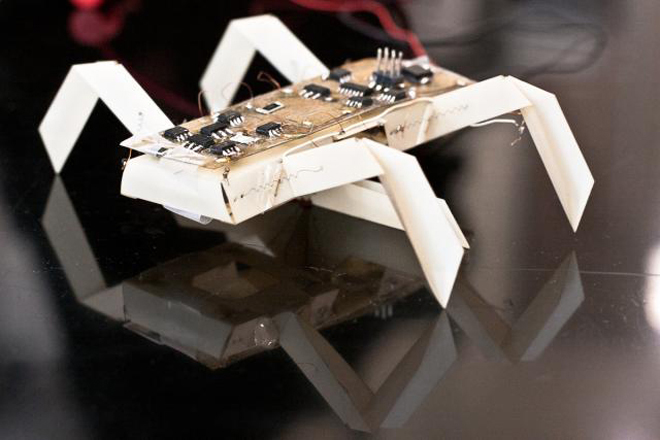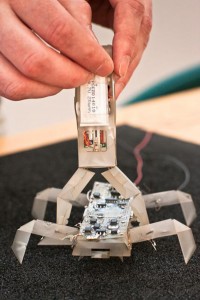Via Wired
-----

Insect printable robot. Photo: Jason Dorfman, CSAIL/MIT
Printers can make mugs, chocolate and even blood vessels. Now, MIT scientists want to add robo-assistants to the list of printable goodies.
Today, MIT announced a new project, “An Expedition in Computing
Printable Programmable Machines,” that aims to give everyone a chance to
have his or her own robot.
Need help peering into that unreasonably hard-to-reach cabinet, or
wiping down your grimy 15th-story windows? Walk on over to robo-Kinko’s
to print, and within 24 hours you could have a fully programmed working origami bot doing your dirty work.
“No system exists today that will take, as specification, your
functional needs and will produce a machine capable of fulfilling that
need,” MIT robotics engineer and project manager Daniela Rus said.
Unfortunately, the very earliest you’d be able to get your hands on
an almost-instant robot might be 2017. The MIT scientists, along with
collaborators at Harvard University and the University of Pennsylvania,
received a $10 million grant from the National Science Foundation for
the 5-year project. Right now, it’s at very early stages of development.
So far, the team has prototyped two mechanical helpers: an
insect-like robot and a gripper. The 6-legged tick-like printable robot
could be used to check your basement for gas leaks or to play with your
cat, Rus says. And the gripper claw, which picks up objects, might be
helpful in manufacturing, or for people with disabilities, she says.

Printable gripper. Photo: Jason Dorfman, CSAIL/MIT
The two prototypes cost about $100 and took about 70 minutes to
build. The real cost to customers will depend on the robot’s
specifications, its capabilities and the types of parts that are
required for it to work.
The researchers want to create a one-size-fits-most platform to
circumvent the high costs and special hardware and software often
associated with robots. If their project works out, you could go to a
local robo-printer, pick a design from a catalog and customize a robot
according to your needs. Perhaps down the line you could even order-in
your designer bot through an app.
Their approach to machine building could “democratize access to
robots,” Rus said. She envisions producing devices that could detect
toxic chemicals, aid science education in schools, and help around the
house.
Although bringing robots to the masses sounds like a great idea (a
sniffing bot to find lost socks would come in handy), there are still
several potential roadblocks to consider — for example, how users,
especially novice ones, will interact with the printable robots.
“Maybe this novice user will issue a command that will break the
device, and we would like to develop programming environments that have
the capability of catching these bad commands,” Rus said.
As it stands now, a robot would come pre-programmed to perform a set
of tasks, but if a user wanted more advanced actions, he or she could
build up those actions using the bot’s basic capabilities. That advanced
set of commands could be programmed in a computer and beamed wirelessly
to the robot. And as voice parsing systems get better, Rus thinks you
might be able to simply tell your robot to do your bidding.
Durability is another issue. Would these robots be single-use only?
If so, trekking to robo-Kinko’s every time you needed a bot to look
behind the fridge might get old. These are all considerations the
scientists will be grappling with in the lab. They’ll have at least five
years to tease out some solutions.
In the meantime, it’s worth noting that other other groups are also building robots using printers. German engineers printed a white robotic spider last year. The arachnoid carried a camera and equipment to assess chemical spills.
And at Drexel University, paleontologist Kenneth Lacovara and mechanical engineer James Tangorra are trying to create a robotic dinosaur from dino-bone replicas.
The 3-D-printed bones are scaled versions of laser-scanned fossils. By
the end of 2012, Lacovara and Tangorra hope to have a fully mobile
robotic dinosaur, which they want to use to study how dinosaurs, like
large sauropods, moved.
Lancovara thinks the MIT project is an exciting and promising one:
“If it’s a plug-and-play system, then it’s feasible,” he said. But
“obviously, it [also] depends on the complexity of the robot.” He’s seen
complex machines with working gears printed in one piece, he says.
Right now, the MIT researchers are developing an API that would
facilitate custom robot design and writing algorithms for the assembly
process and operations.
If their project works out, we could all have a bot to call our own in a few years. Who said print was dead?


